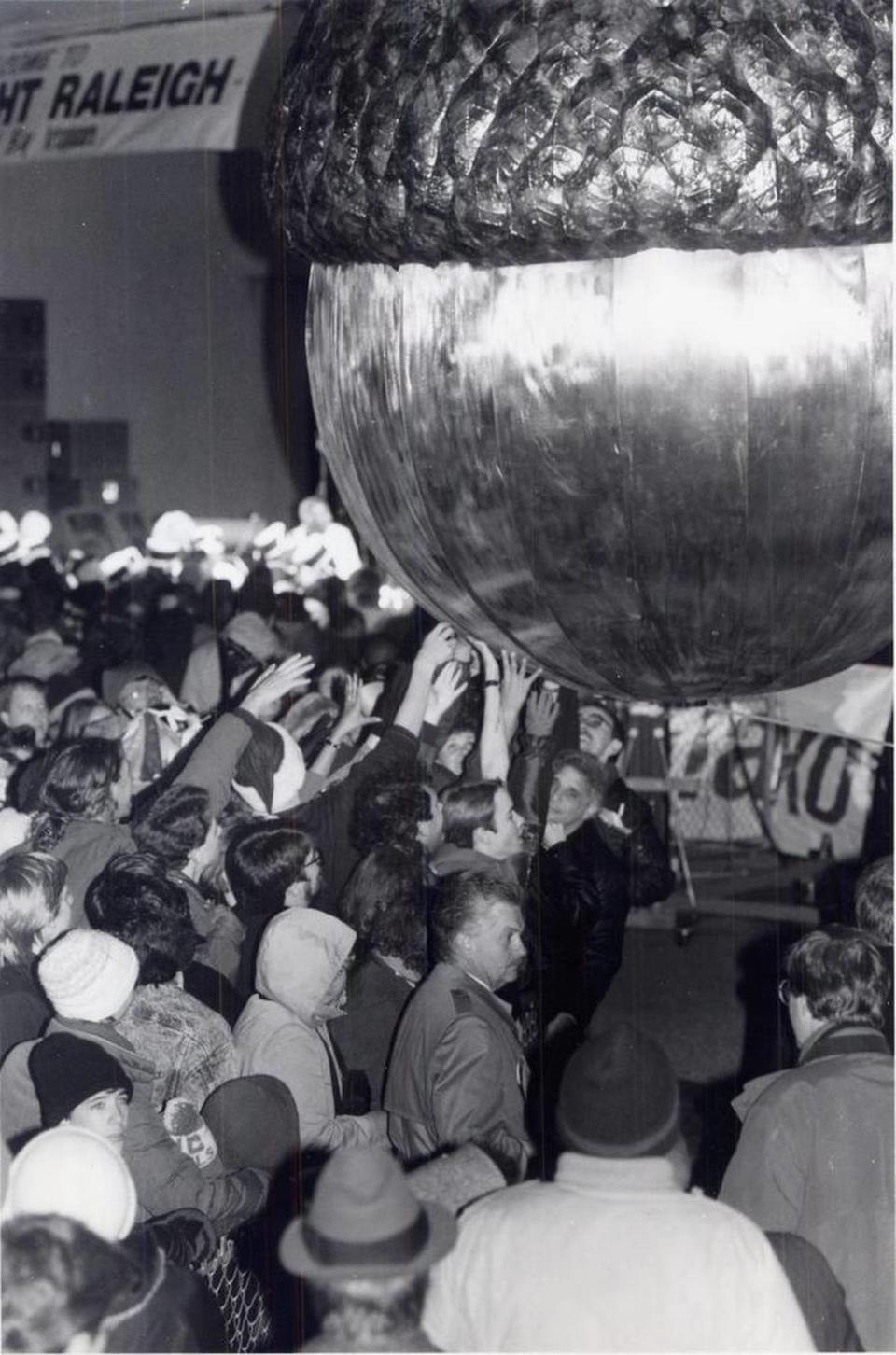How did Raleigh get its quirky, iconic acorn? A New Year’s history that almost wasn’t.
In 1990, Raleigh suffered from a reputation as a dour city short on excitement, desperately seeking a whimsical mascot to rally its sleepy citizens and suggest something like urban flair.
The N&O’s own columnist and my dear late colleague Dennis Rogers put it best when he wrote, “Lord knows, this place has never been Fun City. Nothing wrong with it, you understand. Raleigh is perfectly ... nice.”
This lifelessness flew its proudest banner on Fayetteville Street downtown, still a pedestrian mall in those days, where koi in the concrete pond outnumbered people gathered for amusement after sundown. The storefronts stood mostly empty, and the old Civic Center blocked the south side like a security guard at the world’s loneliest club.
But then, as New Year’s Eve approached, a group of civic-minded folk picked Fayetteville Street to host First Night Raleigh — part of a nationwide movement toward outdoor, alcohol-free celebrations. Raleigh’s marquee for dullness would draw 20,000 people to see something, anything, happen at midnight.
Raleigh had to drop something
But what?
“I wanted something exciting,” said Joedy Lister, who was then program director for Artsplosure. “I wanted something elegant and super cool with some wow factor. But I didn’t know what that was.”
Obviously, the city had to drop something. New York had its ball. Atlanta had its peach.

Lister thought of something round, probably glowing, falling down the wall of the then-Radisson hotel. But this required insurance and various bureaucratic hurdles no one wanted to jump.
The he considered the civic center roof, which offered a good 50- or 60-foot fall. But it had a rubber membrane around the edge — easily damaged.
Strike two.
But around that time, the First Night planners were working alongside a downtown development group headed by John Watkins, a retired lieutenant colonel who’d gone into marketing.
Fitting for the City of Oaks
Without mentioning it to the First Night planners, Watkins had commissioned an acorn sculpture from local artist David Benson, looking for an exciting municipal symbol because Raleigh had just chosen its new slogan: City of Oaks.
Here, finally, was a mascot for the sluggish state capital: a half-ton nut made out of copper.
So, the thinking went, why not dangle this nut off a crane and drop it at midnight?
Lister, months into the planning, resisted.
“I’m trying to do this nice, cool event and it’s going to end up looking like ‘Hee Haw,’ “ he said. “We cannot do a crane on Civic Center Plaza on New Year’s Eve. This is going to look like some terrible small town State Fair!”

But the nut rolled on uncontrollably.
The News & Observer described the 10-foot acorn as “much-anticipated,” and on the big New Year’s night, it arrived downtown escorted by a team of bikers on Harleys.
Lister, chastened by all the excitement, shrugged his shoulders.
“OK,” he said. “But we’re only going to do this one year.”
‘Like it was Bourbon Street’
More than 20,000 people crowded into the downtown streets they had long-since abandoned, and then-N&O scribe Billy Warden chronicled them dancing under the moonlight, seized by an acorn fever as 1991 rolled in.
“Like it was Bourbon Street or something,” he wrote. “Right down those same bricks where poker-faced bankers, lawyers and bureaucrats normally tread.”
Onlookers thought the cable would snap and the acorn would smash to the ground. But it held through its jerky descent, and Raleigh had a new darling.
Dennis Rogers compared the Raleigh in its acorn-induced swoon to “a dowdy aunt who takes a lover late in life.”

“I felt a part of this city that had just awakened for its 200th birthday,” he wrote, noting the city’s bicentennial. “Way to go, old girl.”
As the years went on and the acorn made its annual appearance, Benson would take it through a car wash for cleaning, and once rinse it with phosphoric acid on the terrazzo floors of the civic center, ruining them. He would also spray it with Pam, giving it a sticky sheen.
And now it arrives again for its 33rd display — a copper-colored beacon of originality, the quirky symbol of a city trying awkwardly to be the life of the party.

